I’ve just been informed that the Lake Macquarie landcare nursery has 40 or so plants that would be suitable for the Dick’s creek site.
Now I just need to find suitable locations…
I’ve just been informed that the Lake Macquarie landcare nursery has 40 or so plants that would be suitable for the Dick’s creek site.
Now I just need to find suitable locations…
A perfect day for bush regeneration. Nice temperatures on a cloudy day with soil softened by recent rains.
It has been a disappointment to watch the Sydney golden wattles at the front of the reserve dying. I planted these trees only about four or five years ago so I was surprised to see them pass so quickly.
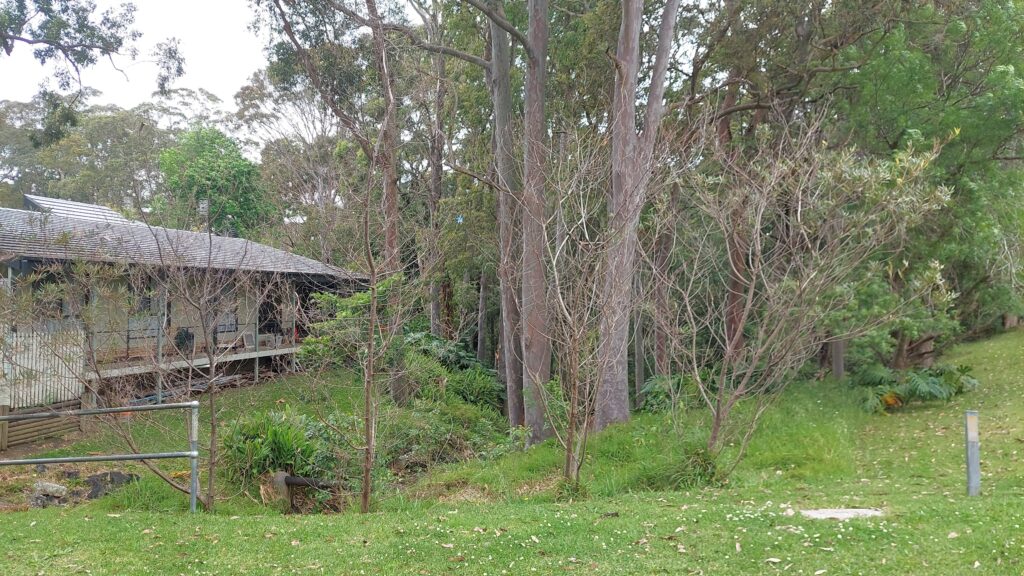

The trunks are being hollowed out by insects. I think the living sections do not have long to live. It is hard to know if the insects killed the tree or if they started devouring the tree after it died.
My first task of the day was to clear some more monstera along the track leading to the bottom of first fall. It is shaping up nicely and I believe it will soon be my preferred track to enter the reserve.
Currently though, this Rhus tree is in the way…
It did use to be a lot larger until I cut it down but it is still going strong. It is going to need to be poisoned to have it gone once and for all.
Today I decided it was a good time to focus on fishbone fern. Fishbone fern is loving the weather and is popping up and taking over in many many locations. It does a great job at establishing itself in difficult locations such as rock faces. From there it can spread out and prevent new growth.
While clearing a stand of fishbone fern from the bottom of first fall I noticed a currawong making full use of a native olive tree. I do get a kick out watching native birds eating from native trees.
The currawong’s nest is nearby so I will be watching the spot underneath for more native olive trees saplings next year.

It was also interesting to check out this red cedar tree that has been growing from underneath the bleeding heart tree. The bleeding heart does not appear to impinge the growth of the red cedar but I suspect the favour will not be returned as the red cedar starts to outgrow the bleeding heart.
I made my way over to the stretch of Gahnia between first and second falls. Some Gahnia was popping up further up the bank so I worked to clear the fishbone fern around that and then I followed the same principle from there.
That is, clear the fishbone fern on the way to and around any natives. Sure enough, while clearing the fishbone fern I found small natives that had not been able to clear the dense fishbone fern. I am sure they will be looking a lot better in the next month or so.
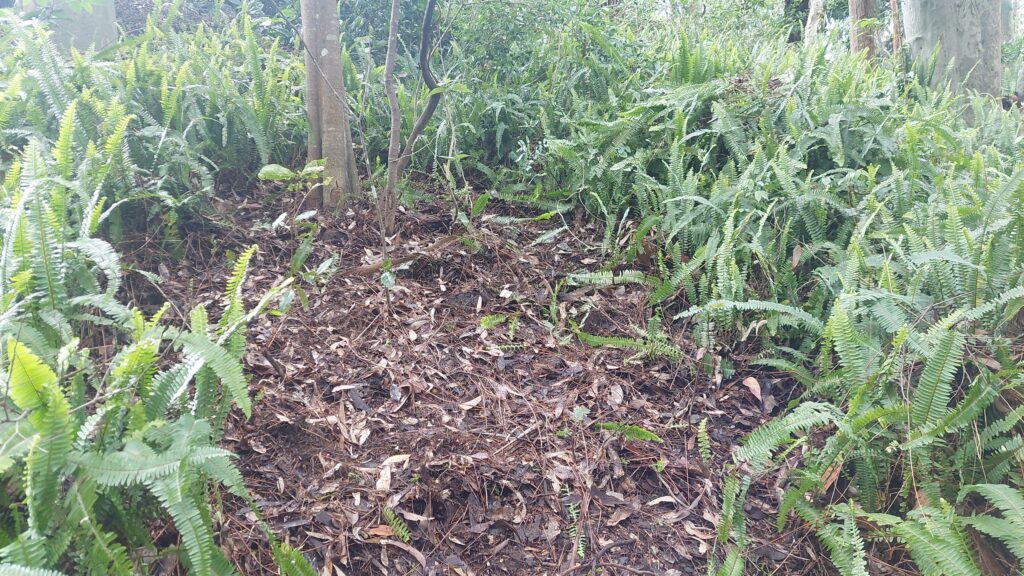
Finally, to keep a promise to myself, I had to clear the lantana off the poison peach tree I noticed a few weeks back. The area, to my horror, has returned to a dense privet forest interlaced with lantana.

This location was largely cleared of privet a few years ago, so it shows how prolific privet can be. On the plus side, these trees are quite young so they should be easier to handle.
Lantana was also going strong at this spot. I was able to remove the main culprit, a large lantana that was spreading in all directions. I can see the weight of the lantana’s branches had striped off some branches off the poison peach tree. This photo shows one side of the tree is lacking in branches. It should be happier now.
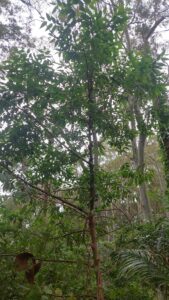
That was enough for the day. Hopefully next weekend produces the same type of weather so I can start tackling those problem areas.
Another late afternoon working bee done and dusted.
Privet has been goading me for a few weeks now. There have been many privet trees that I can spot from the front of the reserve.
In the past I had been relying on manual removal or cutting trees to their base and then removing any regrowth that appeared over time. This, of course, relies on me being on site regularly to ‘tend’ to the regrowth. However, after seeing the amount of regrowth after a quite substantial leave of absence, I have begun to be more willing to use poison. I have been convinced there is no long term impacts from glyphosate and it either kills the plant or greatly hinders their growth.
This was my approach on Saturday. I cut the trees to their base and then applied glyphosate. I will be interested to see the results over the next few weeks or months.
There is still a lot more to do of the same type of work. I was able to get to most privet trees in the upper two levels but there are many more at the lower level. I will be trying to get to them this weekend as they are currently so easy to spot while they are flowering.
A few wins I noticed…
This young pittosporum was hiding behind a small but mature privet tree. I suspect it will take off now that it will be getting more sun. I have noticed that self seeded plants tend to do better than anything I plant. Case in point, the cheese trees in the background that I planted many years ago are still only a few metres tall.
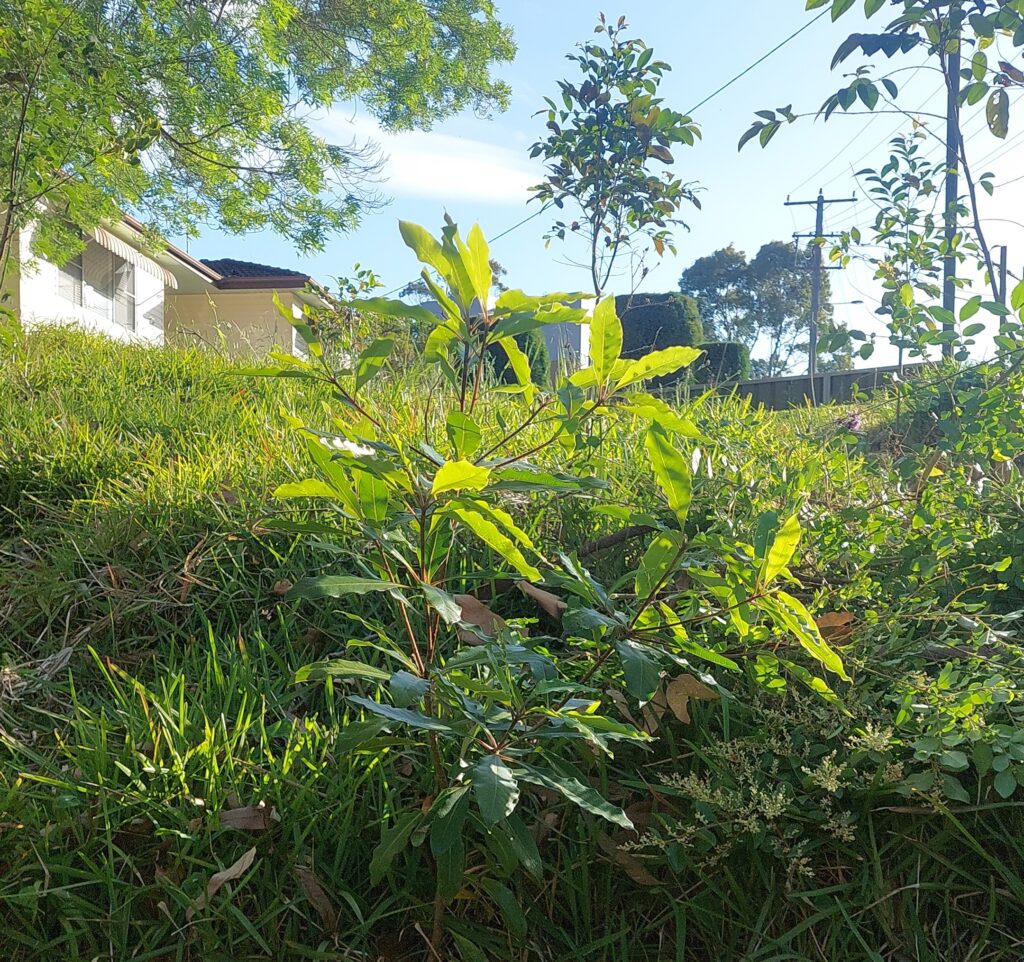
This stand of soft water ferns on the cliff behind fern wall is going strong…
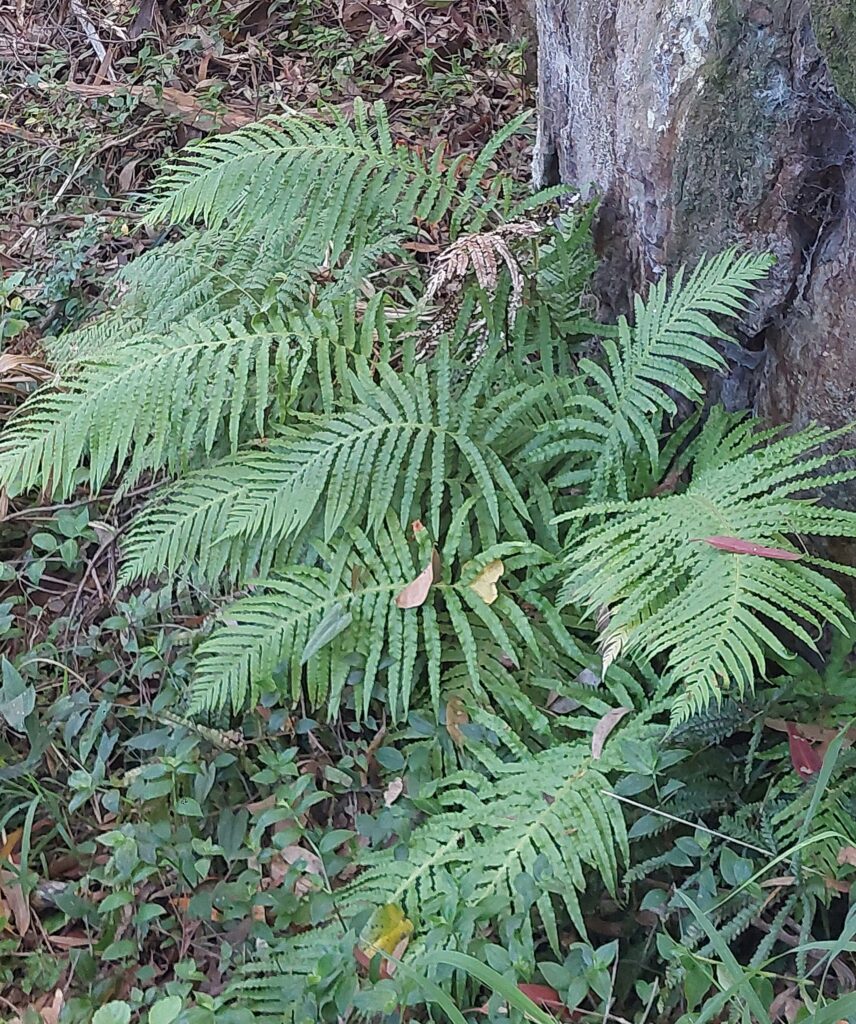
On the path between 2nd fall and site A, I found these Dianella sp. going strong. These were much taller than I had seen previously. Between 1 and 2 meters tall.

In this area there was also a lot of young Sandpaper figs, some Clerodendrums and various other natives. Still, they are in the minority…
On the downside, site A, which I was beginning to call ‘bleeding heart forest’ is back to being called ‘site A’ now that the bleeding hearts have all disappeared. I have no idea what happened…
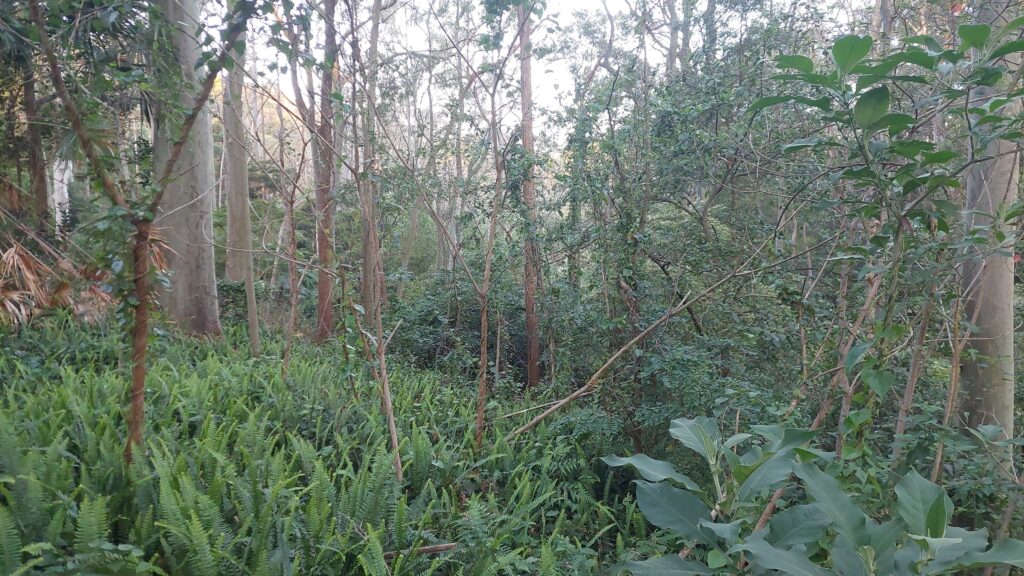
In conclusion, a productive working bee with some pleasant discoveries.
Between first and second falls, across from fern wall is a section covered in saw sedge (Gahnia sp. ).
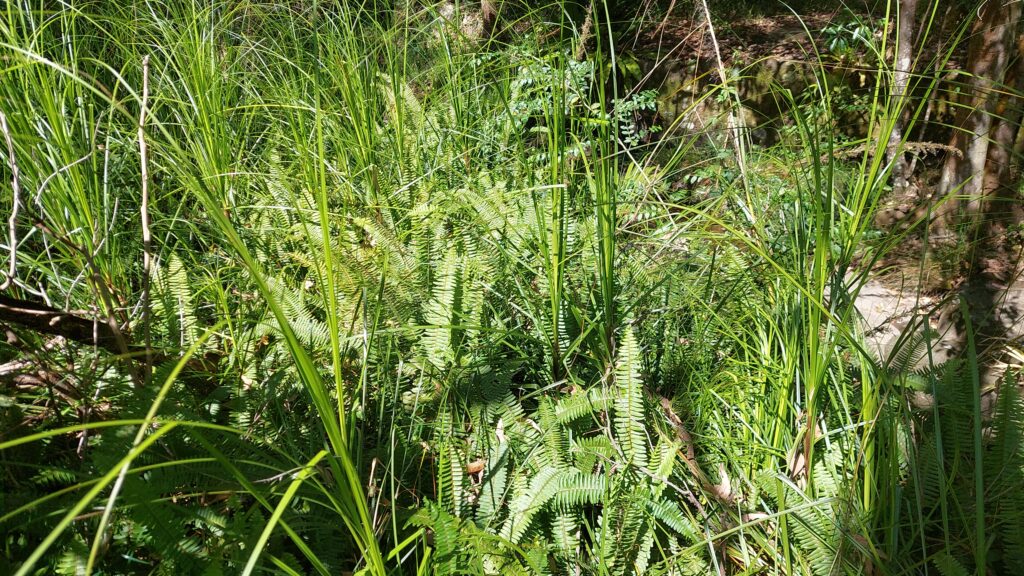
I have been very happy with this section as I had previously thinned out the fishbone fern in the past and the sedge has gone strong since. Still, even from a distance I noticed the fishbone fern making a comeback and on closer inspection it was worse than I thought. The mature sedge is doing well but the fishbone fern was clearly dense enough to hinder new growth.
Fishbone fern is easy to remove but in this case I had to move relatively slowly as to not damage the sedge in the process. It ended up taking a few hours but I feel the result was worth it.
I was also able to maneuver the weed puller between the sedge to allow removal of a small privet tree which was growing from a stump.
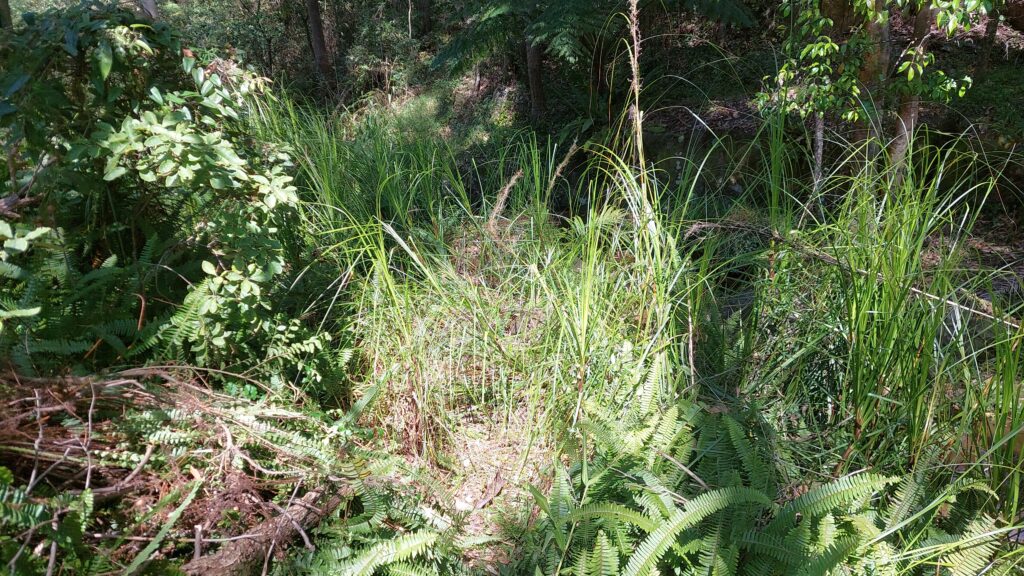
It is going to be interesting to watch this area over the next few months. Hopefully the sedge will beat the fishbone fern into those spots that are now free.
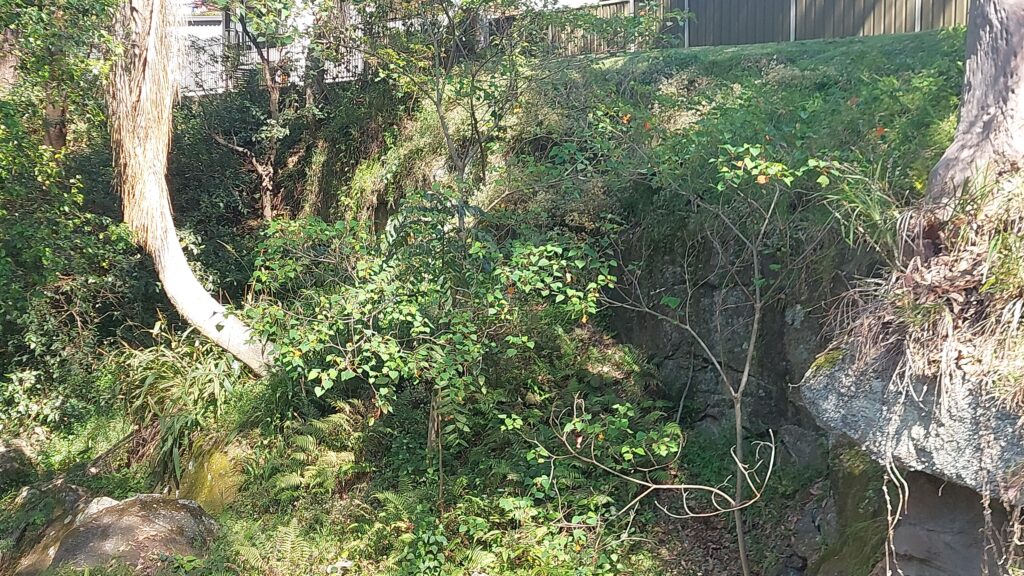
Another working bee completed last Saturday. I had mist flower going strong on the South bank after first falls. It is very easy to spot when it is flowering and unfortunately, it has been prolific.
Disappointingly, by the time I got to the area, I could see a lot of the flowers had gone to seed. Basically it means I will be faced with the same issue next year. Because mist flower tends to break off easily, it can be difficult to get enough of the plant to ensure it won’t grow back. I believe I got most of it at ground level but I have the problem of accessibility with the plants at the top of the cliff. The edge of the cliff is sloped at the top so it becomes risky trying to reach it from the top but the cliff is a bit too high to easily reach from the bottom. I have left the plants on the cliff for a time when I have some equipment to help reach that section.
In the same area I also removed the croften weed, fishbone fern, palm grass and any other unwanted species in the area. I also tried to poison the privet tree that is growing strong at that spot. I am writing this a week after the working bee and I don’t see any effects on the tree so I am beginning to think I went to easy on it.
It was disappointing to leave so much mist flower behind but it won’t be forgotten. It’s time is limited.
As a whole, this area is not doing too badly. Most of the ground is covered in native ferns and a number of trees have sprung up naturally and are going strong. There Bleeding hearts, sandpaper figs, and a red cedar all going strong.
Another positive note, the plants growing on the cliff face to the side of first falls is currently looking great.

There are a few sandpaper figs growing from the cliff face as well as a tree fern on an abundance of maiden hair fern. It all looks quite healthy at present.
I had come to believe the weather was going to prevent any progress in bush regeneration on the weekend but it came good Saturday afternoon so I was able to make small bits of progress here and there.
I ended up staying at the top level and addressed a few things I often notice but always put to the bottom of the priority list. First I removed the bits of mist flower that popped up. It is good to tackle the mist flower at this time of year as it’s white flowers make it easy to spot. Unfortunately, for that reason, I know there is much more on the south bank between first and second falls.
I hacked away at the stands of palm grass and ginger lilly that just keep getting bigger. I dare not remove it in whole as the site would be vulnerable to erosion if deluge hit us. What would be better is to attempt to replace the stands with something native like native ginger or the like.
I also chopped out a lot of Monstera on the north bank. There is still a lot there but I removed it off the trees it was climbing up and started to clear it, starting from the underneath the canopy. I found what could be a decent track to access the creek from the upper level. It has always been covered by the monstera.
Finally, I spent time removing sections of the vine (name escapes me) which has been moving up the tree on the north bank, just besides the properties on Green Valley Rd. It can be seen in the photo below from a few weeks back. I have seen it climbing the tree slowly, killing young tree branches as it moves up. I did not poison the vine but instead, I manually removed sections of the vine from the bark. It was wrapped around the trunk quick thickly. I am hoping it will not take too long to die.

Hopefully the weather will be more accommodating for bush regeneration next weekend.
This is certainly the time of year for Bush regeneration. Good temperatures and soft soil make pulling out invasive weeds so much easier.
My intention was to get to the Bracken fern mound, close to the Sandpaper fig tree I cleared around last week. To do so though, I had to go through Site A and I really could not walk past it while it was in the state it was in.
While fishbone fern dominates this area, it is the privet that concerned me. Fishbone fern is easy to deal with while privet can develop deep roots which can result in a lot more work to remove them and they are well able to push out most other vegetation, especially when combined with lantana.

This next photo shows site A after removing most of the privet and lantana along the back bank of site A. It is hard to see any improvement as there is still a wall of privet at the back of the area.

I cleared site A of lantana and privet and then continued to do the same thing along the bank, past site A. The photo below is me looking back towards site A after finishing up for the day.
I was very happy to see this Poison peach tree (center of image) at the end of the day. I had seen this tree as a young sappling not long after doing some bush regen in the area. I would say it is now fully grown, standing around 5m tall. It joins my list of things to do as I see the lantana has started to encroach on it.

There were a few mystery plants I came across during the day. One vine was identified by a facebook group. Mystery plant – Clematis aristata
Same thing next week, weather permitting.
Perfect weather to do some bush regeneration yesterday.
No rain but the ground has had a good soaking so the weeds couldn’t put up much of a fight when being pulled out.
From my last few visits, I knew a lot more work was required to recover from the neglect of the last few years.
First step: An action plan. I moved around the reserve and tried to list the sections that required attention.
| This stand of ginger lilly and palm grass continues to grow. It needs to be controlled while a native such as native ginger is allowed planted and encouraged. |
|
|
| These Sydney golden wattles were planted only four or five years ago but currently appear to be struggling or dead. Though it is hard to see in this photo, there around about eight Cheese trees which were planted a few years ago. They appear healthy but are clearly failing to make progress against the heavy clay soil. I still hold hope that some of them will find a way to expand their roots to allow more growth. The grass needs to be removed or thinned to allow new growth to have a chance. |
|
|
| First falls is going well. A tree fern and some sandpaper figs are now growing out of the cliff face. |
|
|
| On the south bank, besides first fall, there is some clean up to be done. Fishbone fern is starting to appear, croften weed is still popping up and the privet tree has bounced back. Still, it is mostly in good nick. An hour or so of work should have this area back in good order. |
|
|
| On the south bank, just before the Fern wall, a section of bank is soil rather than the usual rock. Palm grass has taken hold and needs to be addressed. This is true for the entire creek. I imagine an entire day will need to be devoted to removing palm grass. |
|
|
| As a whole though, the section of creek between first and second falls is not all bad. A lot of endemic ferns are going well, the Gahnia on the north bank is more established than ever and most of the visible trees are meant to be there. The issues are the palm grass, the swedish ivy and the fishbone fern. Each of these will take quite some time to address |
|
|
|
|
|
|
| Fern wall, on the south bank between the first and second falls looks good but some bird nest ferns have gone ‘missing’. We have had people steal bird nest ferns in the past and I suspect it has happened again. I can’t be sure until I locate previous images. The ferns that are still there are going spectactular. The tree fern has shot up, as have other tree ferns at other locations. Conditions must of been just right for this species. |
|
|
|
|
| Besides Fern wall though is the swedish ivy that is yet to be removed. Areas that have been done are still clear though so that is a good sign that it can be fully removed. |
|
|
|
|
|
At the top of Second fall, things look mostly ok. There is still privot, palm grass and fishbone fern to address but it is good to see the weeds have not jumped back quickly into this area. |
|
|
| Cabbage tree palm is looking good after some shading trees were removed from a nearby property. |
 |
| Simlarly for the bank behind 16 Green Valley Rd. |
 |
| This photo shows some of the bleeding hearts that have been pushed over. Hopefully more will grow when the fishbone fern is removed. |
 |
| There is a stretch of poisoned lantana at 16 Green Valley Rd. I am not sure what the purpose is. |
 |
| This area is kept clear by the property owners above. |
 |
| Lots of privet in this area towards the creek as well. |
 |
| One positive discovery was finding this poison peach tree. There were also some young sapling nearby. I was able to free them from the lantana which was starting to get on top of it. It is about three metres tall. |
 This poison peach tree and some younger saplings was covered in lantana. It is about three metres in height |
| A wall of privet… |
 |
| But amongst it… |
 |
 |
 |
 |
 |
 |
 |
 |
 |
 |
 |
 |
 |
 |
 |
 |
 |
 |
After this point I went along my usual route along the creek back to the track that leads to site A but it was so infested with lantana and the privet it was a battle to move and taking any photos was not really an option. It is going to take a lot of time to get it back to the state I had it at a few years back.
Dependent on the weather, this weekend should be good for another Working Bee. If you would like to volunteer some time for Bush Regeneration at Dick’s Creek Landcare, please let me know via the contact page.
Was able to do a solid 3hrs on the Saturday which felt quite productive. Great day for bush regeneration with a cloudy day keeping it quite cool and previous rains making the soil easy to work with.
We have had a lot of rain so everything is growing well at the moment.
Including the weeds unfortunately. The track from second fall that I normally use had been swallowed by fishbone ferns.
So that was a good place to start… I looked through the fishbone fern for any natives and cleared around those. I found pittosporums, false bracken, blue flax lilly and others who were all doing their best to stay above the fishbone fern. I have done this multiple times now and each time the desired native plants get more numerous and larger. It is all heading in the right direction.
A native olive tree that I had previous cleared around is doing well with new growth showing but no new shoots closer to the cliff were visible. Still, other natives were taking advantage so that’s a win.
Notice the blue flax lilly and elderberry panax in the bottom left corner…
After this I moved down the lower creek section and pushed back lantana around a stand of bracken that I have posted about previously. Unfortunately the rain came in so no photos.
There are many seedlings of desired species popping up at present. Another two years will see a transformation I believe.
One last thing I could not resist taking a photo of was this spider. A beautiful specimen I thought… A golden orb spider I have been informed.
I’m looking forward to next weekend. My intention is to once again look for natives that need some more space to grow but there is also an infestation of Swedish Ivy that needs attention. It has been disturbing to see it popping up in more and more places.